The Role of Lipids in TPN Formulations
The Essential Role of Lipids in Total Parenteral Nutrition
Lipids are a cornerstone of total parenteral nutrition (TPN), serving multiple biological and clinical functions. As a dense source of energy and vital nutrients, lipids support cellular integrity, immune modulation, and metabolic balance. This comprehensive review explores the types, properties, functions, and clinical guidelines related to lipids in TPN formulations, emphasizing their importance in maintaining health and optimizing patient outcomes.
Fundamental Biological Functions of Lipids in TPN
What are the primary functions of lipids in TPN formulations?
Lipids are a vital component of total parenteral nutrition (TPN), fulfilling multiple critical roles in patient health. Their primary function is to act as the main source of essential fatty acids, which are nutrients that the body cannot synthesize on its own. Linoleic acid (omega-6) and alpha-linolenic acid (omega-3) are two essential fatty acids that must be supplied through diet or intravenous nutrition. Without adequate lipid provision, deficiency symptoms such as scaly skin, growth failure, and hair loss can develop within a few weeks.
Beyond supplying these essential nutrients, lipids serve as a highly concentrated energy source. They provide about 9 kcal per gram, making them efficient for meeting caloric needs while minimizing fluid volume, which is especially helpful in patients with fluid restrictions.
In addition to energy, lipids are integral to the structure and function of cell membranes. They form the lipid bilayer, which maintains cell integrity, regulates permeability, and influences cellular communication. The types of fatty acids within lipids—such as omega-3, omega-6, and monounsaturated fats—affect membrane fluidity and receptor activity.
Lipids also play a significant role in cellular signaling pathways. They are precursors to various bioactive mediators, including eicosanoids like prostaglandins and leukotrienes. These mediators are involved in regulating inflammation, immune responses, and tissue repair.
In the context of clinical outcomes, lipids influence immune function and inflammatory processes. Certain formulations rich in omega-3 fatty acids (from fish oil) can exert anti-inflammatory effects, potentially reducing complications like PN-associated liver disease or infections.
In summary, lipids in TPN are essential not only for nutritional adequacy but also for maintaining cellular structure, modulating immune responses, and supporting overall metabolic functions vital for patient recovery and health maintenance.
Types, Composition, and Properties of Lipid Emulsions in TPN
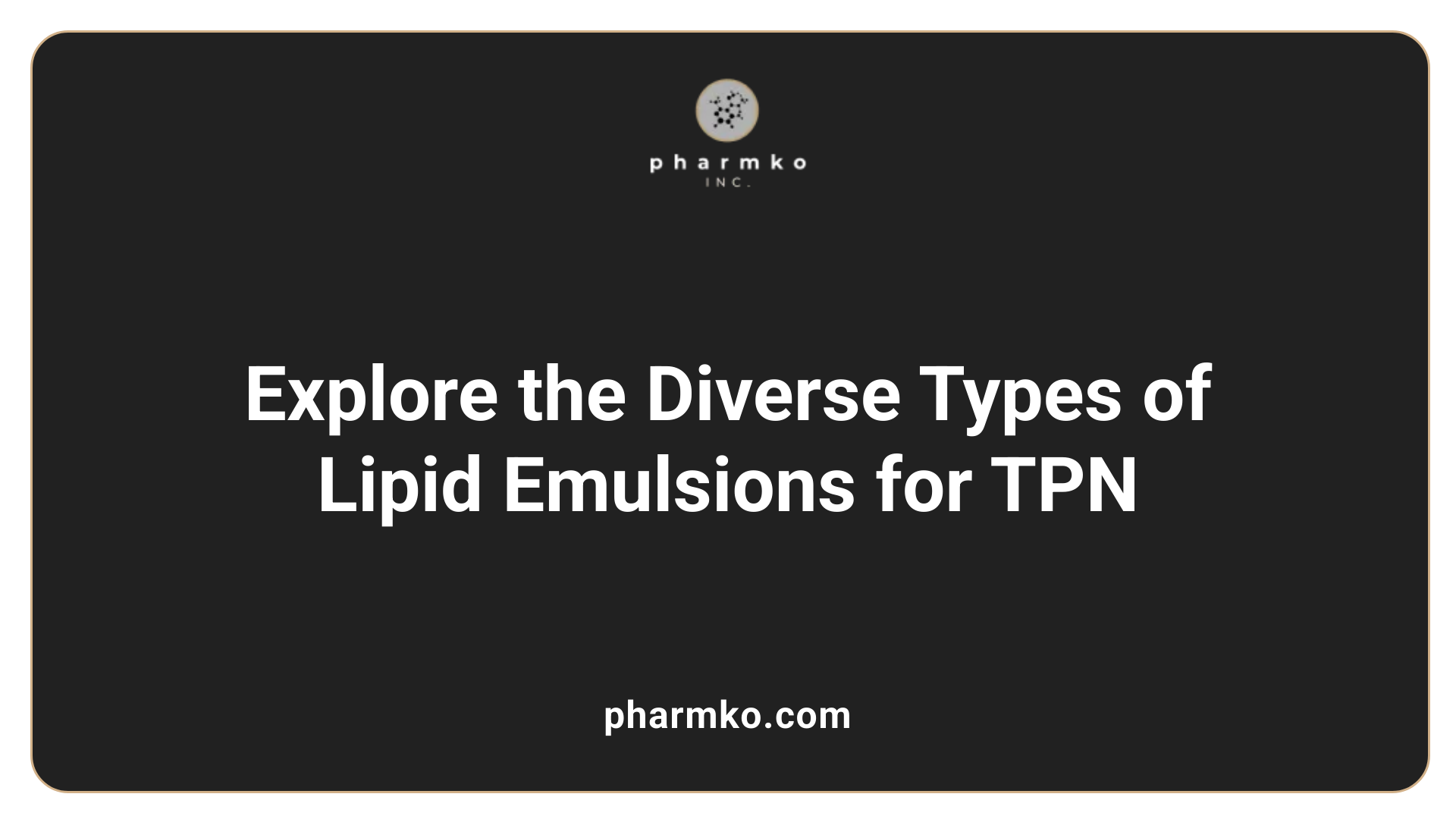 Lipid emulsions used in total parenteral nutrition (TPN) are formulated from various sources, each offering distinct fatty acid profiles and clinical benefits.
Lipid emulsions used in total parenteral nutrition (TPN) are formulated from various sources, each offering distinct fatty acid profiles and clinical benefits.
Common sources include soybean oil, olive oil, fish oil, and medium-chain triglycerides (MCTs). Soybean oil-based emulsions are rich in omega-6 polyunsaturated fatty acids (PUFAs), notably linoleic acid, which can promote inflammatory processes if used excessively. Olive oil emulsions contain predominantly monounsaturated fats like oleic acid, associated with reduced lipid peroxidation and oxidative stress. Fish oil emulsions are high in omega-3 PUFAs such as EPA and DHA, known for their anti-inflammatory and immune-modulating effects. MCTs are rapidly metabolized, providing quick energy and are often included in mixed formulations.
The fatty acid profiles directly influence the emulsions’ biological effects.
| Lipid Source | Composition | Clinical Implications | Example Emulsion Names | Additional Notes |
|---|---|---|---|---|
| Soybean oil | High omega-6 PUFAs, phytosterols, vitamin E | Pro-inflammatory potential, risk for liver toxicity | Intralipid | Most common in clinical use |
| Olive oil | Monounsaturated fats (oleic acid) | Less inflammation, antioxidant-rich | Clinolipid | Associated with reduced oxidative harm |
| Fish oil | EPA, DHA, omega-3 PUFAs | Anti-inflammatory, immune support | Omegaven | Used in reversing PN-associated cholestasis |
| MCT oils | Medium-chain triglycerides | Rapid oxidation, energy source | Various formulations | Often combined with LCTs |
The properties of these emulsions, such as stability and fatty acid content, depend on their composition. Fish oil emulsions, for example, are less prone to oxidative damage and are beneficial in reducing inflammation. Olive oil emulsions tend to have high stability owing to monounsaturated fats, making them less susceptible to lipid peroxidation.
In selecting an emulsion, clinicians consider factors like the inflammatory status of the patient, metabolic needs, and potential liver impact. Emerging evidence supports the use of mixed oils, which combine different fat sources to optimize outcomes and minimize adverse effects.
Ultimately, the fatty acid composition of lipid emulsions significantly influences their immunological and inflammatory responses, making tailored selection essential for specific clinical situations.
Lipids and Immune Function: Supporting Defense Mechanisms
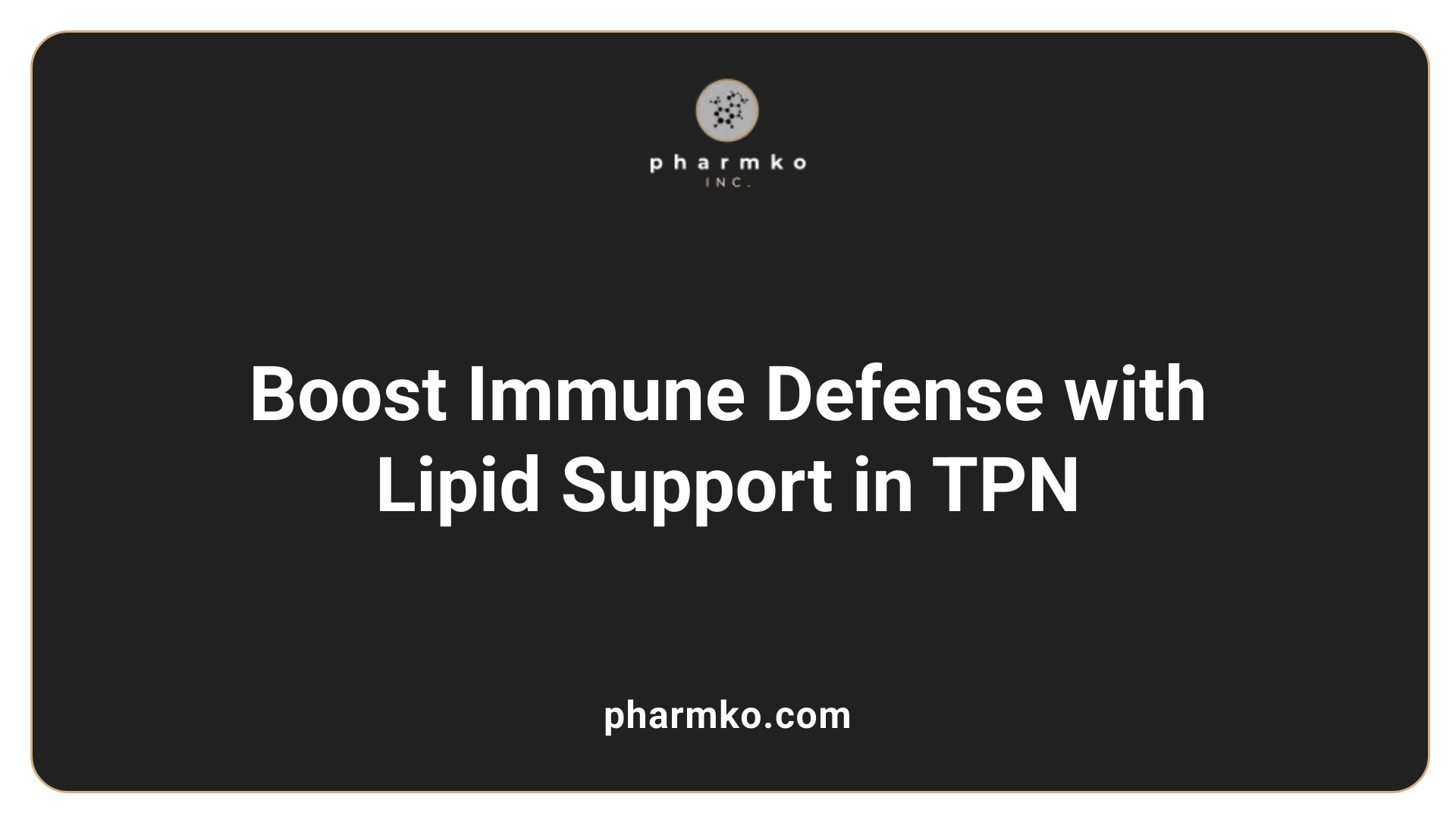
What is the role of lipids in supporting immune function and managing inflammation in parenteral nutrition?
Lipids are fundamental in maintaining immune health and controlling inflammation, especially in patients receiving parenteral nutrition (PN). They serve as a primary source of essential fatty acids—linoleic acid (omega-6) and alpha-linolenic acid (omega-3)—which the body cannot produce on its own. These fatty acids are precursors to bioactive lipid mediators that influence immune responses.
Omega-3 fatty acids, particularly eicosapentaenoic acid (EPA) and docosahexaenoic acid (DHA) found in fish oil emulsions, are known for their anti-inflammatory properties. They lead to increased production of specialized pro-resolving mediators (SPMs) like resolvins and protectins, which actively terminate inflammation and promote resolution. This mechanism helps modulate immune reactions and reduce tissue injury caused by excessive inflammation.
In contrast, omega-6 fatty acids, abundant in soybean oil-based emulsions, tend to promote the production of pro-inflammatory eicosanoids, such as prostaglandins and leukotrienes. Elevated levels of these mediators can exacerbate inflammation, impair immune defenses, and contribute to complications like PN-associated liver disease.
Different lipid sources can shift the balance between pro-inflammatory and anti-inflammatory pathways. For example, olive oil—rich in monounsaturated oleic acid—exhibits less inflammatory potential, and mixtures containing MCT and fish oil are designed to optimize metabolic and immunologic effects.
Modulating the types of lipids in PN allows clinicians to influence immune responses positively. By incorporating omega-3-rich emulsions, it is possible to temper inflammatory reactions, support immune function, and promote better clinical outcomes, especially in critically ill and post-surgical patients.
| Lipid Type | Content & Effects | Clinical Implications |
|---|---|---|
| Soybean oil (n-6 PUFA) | Promotes inflammation, high phytosterols | May worsen inflammatory response and liver issues |
| Fish oil (n-3 PUFA) | Anti-inflammatory, EPA and DHA | Modulates immune response, supports resolution of inflammation |
| Olive oil (monounsaturated) | Less prone to oxidation, less inflammatory | Suitable for less inflammatory profiles |
| MCT/Long-chain Fats | Metabolized rapidly, modulate immune effects | Used in combination to optimize effects |
In conclusion, the composition of lipid emulsions in PN significantly influences immune function and inflammation. Tailoring lipid sources based on patient needs can optimize immune support, minimize inflammatory damage, and enhance recovery.
Preventing Fatty Acid Deficiency: Nutritional Significance of Lipids in TPN
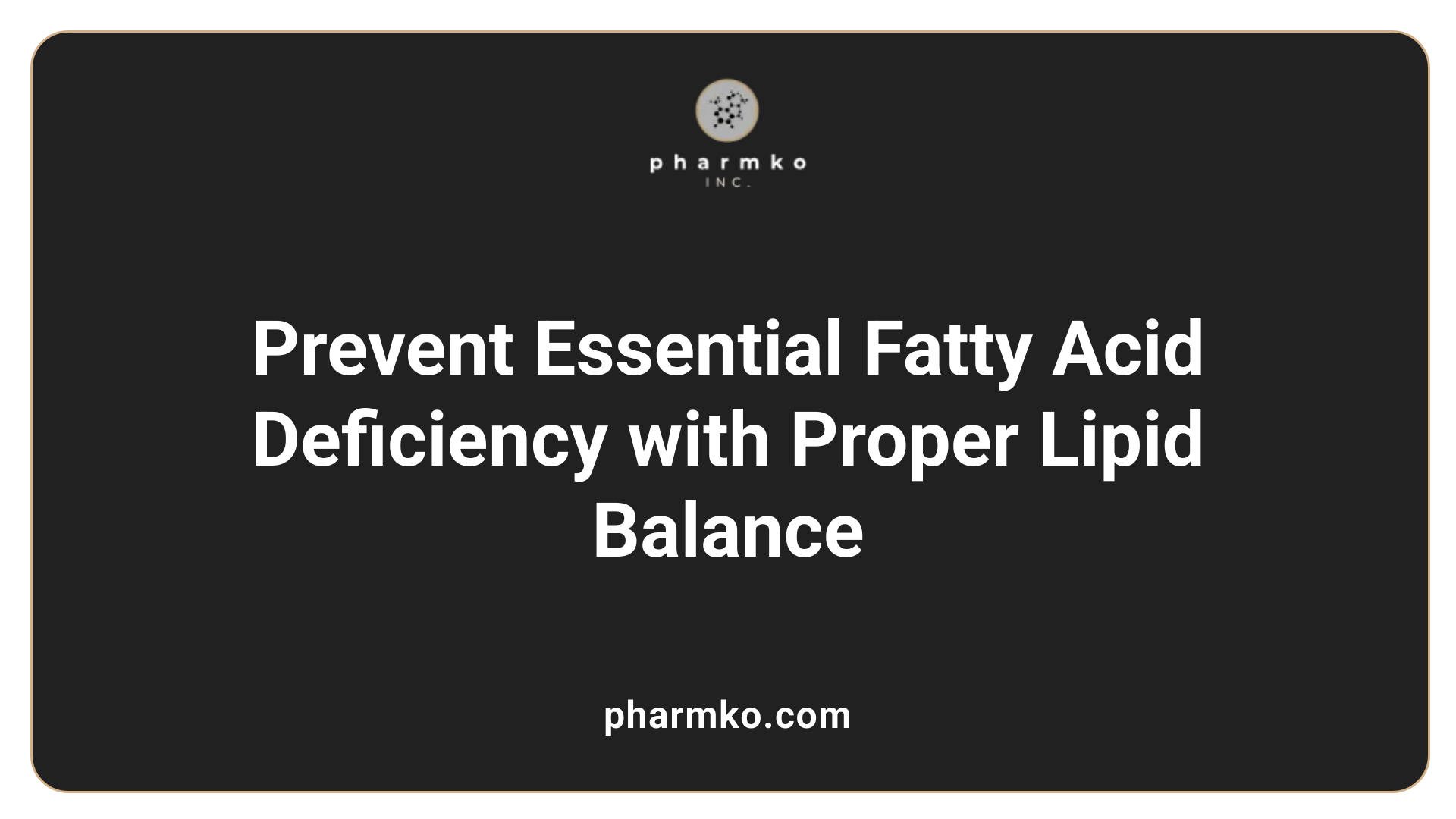
What is the significance of lipids in preventing fatty acid deficiency and maintaining nutritional balance in TPN?
Lipids play a vital role in total parenteral nutrition (TPN) because they supply essential fatty acids (EFAs) like linoleic acid (LA) and alpha-linolenic acid (ALA). These fatty acids are crucial because the human body cannot synthesize them, yet they are fundamental for cell membrane structure, immune function, and inflammatory responses.
Inadequate lipid provision can lead to essential fatty acid deficiency (EFAD), characterized by symptoms such as dry, scaly skin, poor wound healing, and growth failure. Biochemically, EFAD is indicated by an elevated triene:tetraene (T:T) ratio, typically greater than 0.083 in infants under one month. To prevent this, it’s recommended that lipid intake constitutes at least 3.2% of total calories, or about 15% of energy intake orally, with a minimum of approximately 100 grams of lipids weekly.
Common lipid emulsions, especially soybean oil-based formulations rich in LA, are used to supply these essential fatty acids effectively. This intake is particularly critical for patients with malabsorption or those on prolonged fat-free TPN, who are at higher risk of developing EFAD.
Monitoring biochemical markers like the T:T ratio helps ensure patients maintain EFA levels, preventing deficiency symptoms. Ensuring proper lipid formulation and dose in TPN preserves nutritional balance and supports overall health, emphasizing the fundamental role of lipids in parenteral nutritional therapy.
Administration Protocols and Guidelines for Lipid Use in TPN
What are the clinical guidelines for incorporating lipids into TPN?
The clinical practice for including lipids in total parenteral nutrition (TPN) revolves around ensuring they meet the essential energetic and nutritional needs of patients while minimizing risks.
Lipids are regarded as a vital component that provides concentrated calories and essential fatty acids (EFAs). As a standard, lipid infusion should generally begin within the first week (≤7 days) of initiating TPN to prevent EFA deficiency, which can occur within three weeks of fat-free nutrition.
The typical dosing of lipid emulsions ranges from 0.7 to 1.3 grams of triglycerides per kilogram of body weight each day. This range can be adjusted based on patient clinical status, with critically ill patients sometimes receiving higher doses up to 2 g/kg/day, especially if additional caloric supplementation is necessary.
Monitoring serum triglyceride levels is crucial during lipid infusion to prevent hypertriglyceridemia, which could lead to complications such as fat overload syndrome. Regular laboratory assessments include triglycerides, liver function tests, and essential fatty acid levels.
Guidelines stipulate that the phospholipid to triglyceride ratio in lipid emulsions should be optimized to enhance safety and efficacy. Concurrent administration of vitamin E is recommended to mitigate lipid peroxidation and oxidative stress.
In adult patients, lipids typically supply about 25–40% of non-protein calories in the TPN regimen. In patients with respiratory issues or those who are critically ill, this can be increased to 50–60% to meet elevated metabolic demands.
The role of fish oil-containing lipid emulsions is increasingly supported by clinical studies, highlighting their anti-inflammatory benefits and safety profile, especially in cases of parenteral nutrition-associated liver disease (PNALD).
Overall, these guidelines serve to balance essential nutrient delivery with safety, tailoring lipid use to individual patient needs and conditions.
Evolving Lipid Emulsions: From Traditional to Modern Formulations
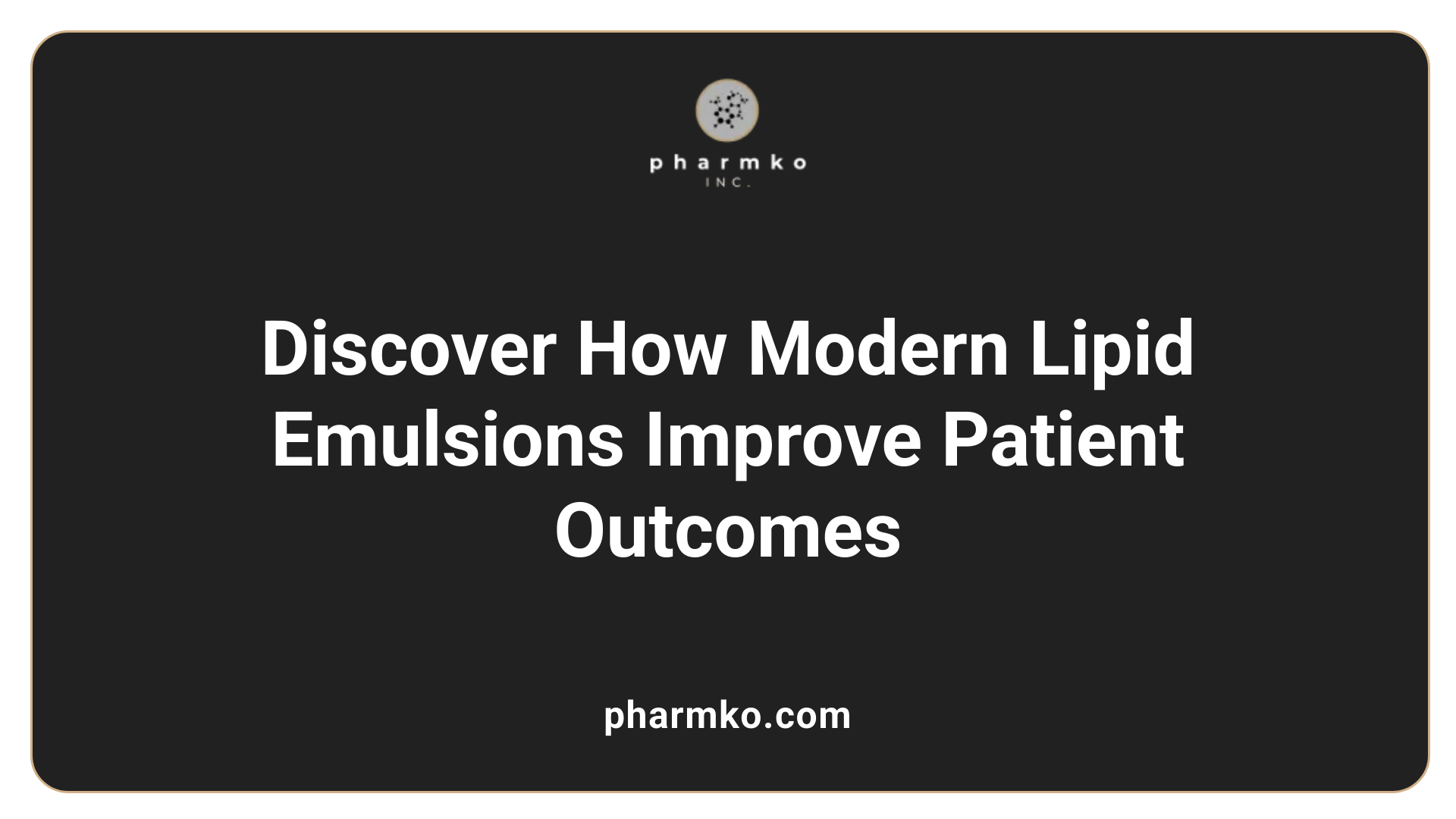
How have lipid emulsions evolved in recent years to improve clinical outcomes?
Lipid emulsions (LEs) used in parenteral nutrition (PN) have significantly advanced from their initial formulations to more sophisticated options aimed at optimizing patient health.
Historically, soybean oil-based emulsions (SOLEs) were the standard, providing essential fatty acids and energy. However, these emulsions contained high levels of omega-6 polyunsaturated fatty acids (PUFAs) like linoleic acid, which could promote inflammation, oxidative stress, and liver toxicity with prolonged use.
Modern developments introduced alternative modifications, replacing some or all soybean oil with oils that have favorable fatty acid profiles. For example, olive oil-based emulsions feature monounsaturated oleic acid and lower omega-6 content, leading to less lipid peroxidation and oxidative damage.
Mixtures incorporating medium-chain triglycerides (MCTs) have been designed to improve metabolic handling, as MCTs are rapidly oxidized for energy, producing ketones and causing less accumulation. Additionally, fish oil emulsions are rich in omega-3 PUFAs like EPA and DHA, which serve as precursors to anti-inflammatory mediators, modulating immune response and reducing inflammation.
These innovations are supported by emerging clinical evidence. Studies suggest that mixed lipid emulsions, including SMOFlipid (a blend of soybean oil, MCT, olive oil, and fish oil), can decrease markers of liver injury and improve inflammatory profiles. Fish oil emulsions like Omegaven® have shown promise in reversing PN-associated liver disease, especially in pediatric patients.
Overall, these newer formulations aim to mitigate adverse effects like inflammation and liver toxicity while enhancing immunity and clinical recovery, making lipid emulsions more effective and safer in diverse patient populations.
Monitoring and Managing Lipid Therapy in TPN
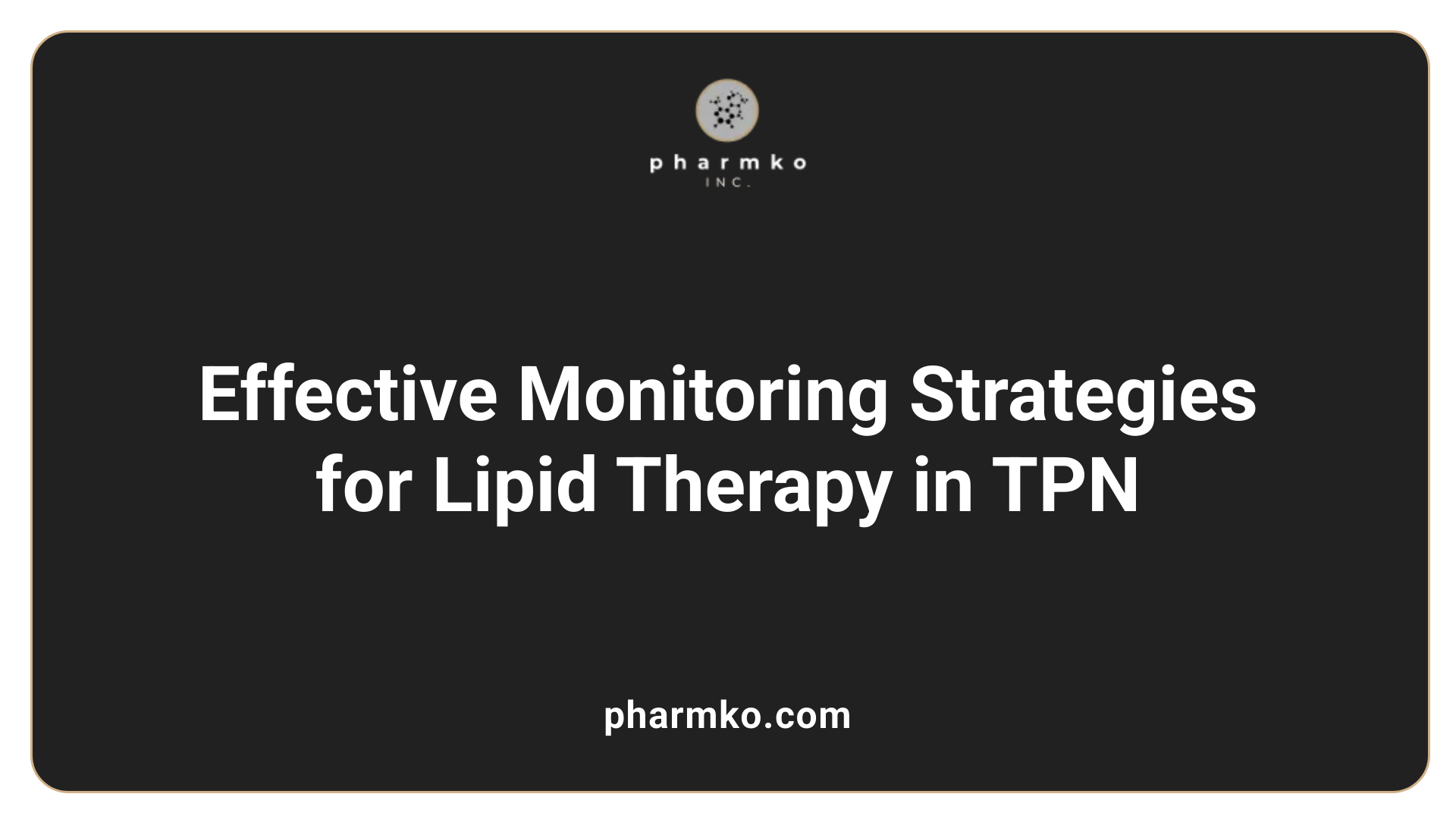
How is lipid therapy monitored and managed in patients receiving TPN?
Effective management of lipid therapy in parenteral nutrition (PN) requires careful monitoring of several clinical and laboratory parameters. Healthcare providers routinely assess serum triglyceride levels to detect hypertriglyceridemia, which can indicate lipid overload or impaired lipid clearance. Liver function tests are also monitored regularly, as elevated liver enzymes may signal hepatic stress or emerging PN-associated liver disease.
Clinicians watch for physical signs of lipid overload, such as fat globules visible in infusion lines, lipid emboli, or lipid rings around the catheter site. Close observation helps prevent complications like fat overload syndrome, which can lead to respiratory distress and cardiovascular issues.
For pediatric and long-term PN patients, the approach involves titrating lipid doses carefully to balance adequate essential fatty acid intake against the risk of metabolic disturbances. Typical lipid dosing does not exceed 1 g/kg/day, though this varies depending on individual metabolic tolerance and clinical condition.
Adjustments in infusion rates are essential to prevent lipemia—thickening of the blood due to excess lipids—and to maintain metabolic stability. Slower infusion rates, usually over 12-24 hours, help mitigate the risk of fat overload. If triglyceride levels exceed safe thresholds or liver enzymes become elevated, clinicians may reduce the lipid dose, temporarily suspend lipids, or switch to alternative emulsions such as fish oil-based products. These alternatives provide hepatoprotective benefits and may improve inflammatory profiles.
In summary, regular laboratory assessments combined with vigilant clinical observation allow for tailored lipid management, minimizing adverse effects while ensuring patients receive necessary essential fatty acids to support cell function and immune health.
Risks, Contraindications, and Special Populations in Lipid Use
Can TPN be administered without lipids, and what are the implications of lipid omission?
Administering total parenteral nutrition (TPN) without lipids is technically possible but generally not recommended. Lipids play a crucial role in providing essential fatty acids, which the body cannot synthesize, and serve as a dense energy source.
Omitting lipids from TPN increases the risk of essential fatty acid deficiency (EFAD), which can manifest as dry, scaly skin, alopecia, growth failure, and impaired immune responses.
Furthermore, lipid-free TPN has been associated with hepatic dysfunction, especially when administered over extended periods. Studies indicate higher rates of cholestasis and liver injury in patients receiving lipid-free PN compared to those with lipid supplementation.
Including lipids, such as soybean oil, olive oil, or fish oil emulsions, helps maintain metabolic stability, supports immune function, and protects the liver. In particular, formulations containing monounsaturated or omega-3 fatty acids may offer additional benefits for critically ill or long-term PN patients.
In summary, while lipid omission from TPN is feasible, it poses significant risks, emphasizing the importance of lipid inclusion to promote optimal clinical outcomes and prevent metabolic complications.
Optimizing Lipid Use in Parenteral Nutrition
Lipids are indispensable components of TPN, providing essential nutrients, energy, and immune support. Advances in lipid formulations have expanded options, allowing healthcare providers to tailor therapy to individual patient needs—balancing inflammatory modulation, hepatic safety, and metabolic demands. Strict adherence to clinical guidelines, vigilant monitoring, and ongoing research are vital to maximizing benefits and minimizing risks associated with lipid use in parenteral nutrition. As understanding evolves, the integration of innovative lipid emulsions promises enhanced patient outcomes across diverse clinical settings, establishing lipids as a cornerstone of effective parenteral nutritional strategies.
References
- Parenteral Nutrition and Lipids - PMC - PubMed Central
- Lipids in parenteral nutrition – expert consensus statements
- Total Parenteral Nutrition - StatPearls - NCBI Bookshelf
- Immune modulation by parenteral lipid emulsions - ScienceDirect.com
- Composition and Functionality of Lipid Emulsions in Parenteral ...
- Parenteral Nutrition Formulation - BAPEN
- [PDF] Intravenous Lipid Emulsions Management Clinical Pathway
- Lipid emulsions in parenteral nutrition of intensive care patients













